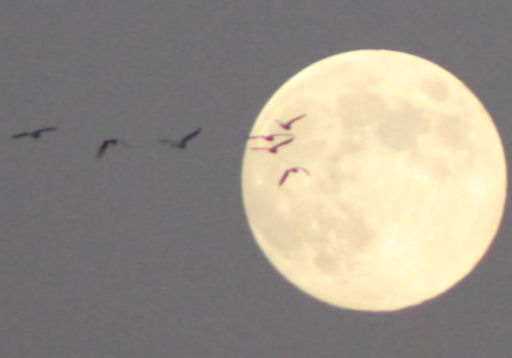BLUE MOON: Tonight's full Moon is the second full Moon this month. According to modern folklore, that makes it a "Blue Moon." Strange but true: Most blue moons look red, pink or gray. On rare occasions, however, the Moon can actually turn blue. A video from NASA explains how.
Richard Sears photographed the waxing full Moon last night from Atwater, California. It was not blue:
For more pictures of the Moon--red, blue, and otherwise--browse the realtime gallery:

![]()
Solar wind
speed: 316.4 km/sec
density: 0.5 protons/cm3
explanation | more data
Updated: Today at 1446 UT
![]()
X-ray Solar Flares
6-hr max: C1 1004 UT Aug31
24-hr: C2 0721 UT Aug31
explanation | more data
Updated: Today at: 1400 UT
![]()
![]()
![]()
Daily Sun: 31 Aug 12
![]()
![]()
Sunspot complex 1562-1563 is crackling with C-class solar flares. Credit: SDO/HMI
![]()
![]()
![]()
Sunspot number: 118
What is the sunspot number?
Updated 31 Aug 2012
Spotless Days
Current Stretch: 0 days
2012 total: 0 days (0%)
2011 total: 2 days (<1%)
2010 total: 51 days (14%)
2009 total: 260 days (71%)
Since 2004: 821 days
Typical Solar Min: 486 days
Update 31 Aug 2012
The Radio Sun
10.7 cm flux: 128 sfu
explanation | more data
Updated 31 Aug 2012
![]()
![]()
![]()
Current Auroral Oval:
![]()
Switch to: Europe, USA, New Zealand, Antarctica
Credit: NOAA/POES
![]()
![]()
![]()
Planetary K-index
Now: Kp= 1 quiet
24-hr max: Kp= 1 quiet
explanation | more data
![]()
Interplanetary Mag. Field
Btotal: 2.3 nT
Bz: 1.3 nT north
explanation | more data
Updated: Today at 1446 UT
![]()
![]()
![]()
Coronal Holes: 31 Aug 12
![]()
![]()
There are no large coronal holes on the Earthside of the sun. Credit: SDO/AIA.





